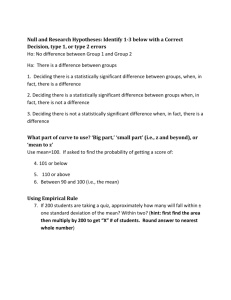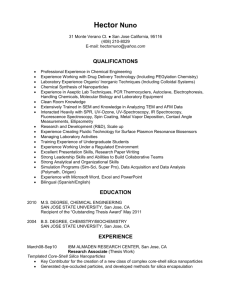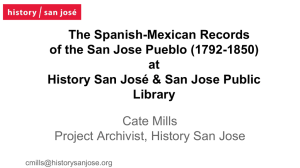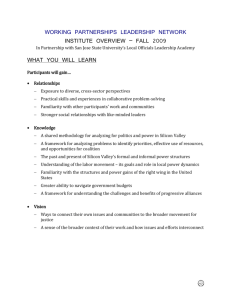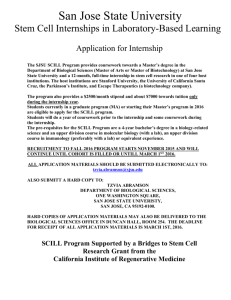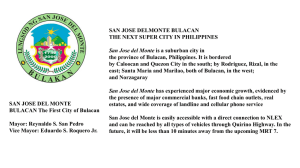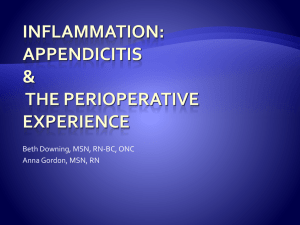The San Jose Music Project: A New Class of Collaboration
advertisement
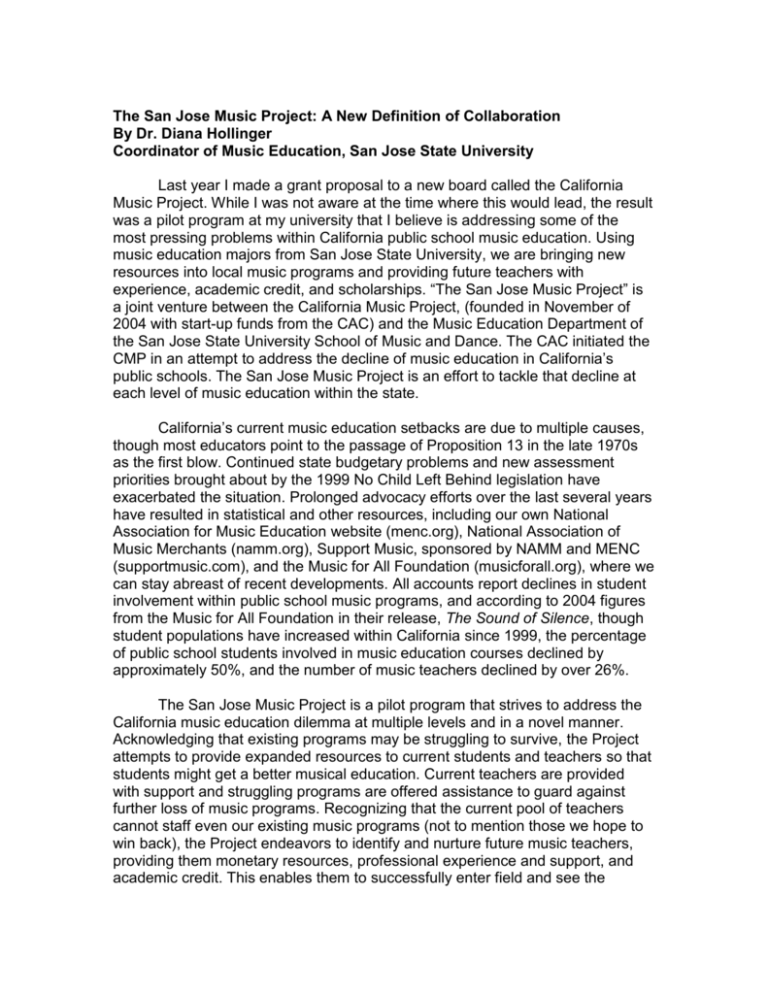
The San Jose Music Project: A New Definition of Collaboration By Dr. Diana Hollinger Coordinator of Music Education, San Jose State University Last year I made a grant proposal to a new board called the California Music Project. While I was not aware at the time where this would lead, the result was a pilot program at my university that I believe is addressing some of the most pressing problems within California public school music education. Using music education majors from San Jose State University, we are bringing new resources into local music programs and providing future teachers with experience, academic credit, and scholarships. “The San Jose Music Project” is a joint venture between the California Music Project, (founded in November of 2004 with start-up funds from the CAC) and the Music Education Department of the San Jose State University School of Music and Dance. The CAC initiated the CMP in an attempt to address the decline of music education in California’s public schools. The San Jose Music Project is an effort to tackle that decline at each level of music education within the state. California’s current music education setbacks are due to multiple causes, though most educators point to the passage of Proposition 13 in the late 1970s as the first blow. Continued state budgetary problems and new assessment priorities brought about by the 1999 No Child Left Behind legislation have exacerbated the situation. Prolonged advocacy efforts over the last several years have resulted in statistical and other resources, including our own National Association for Music Education website (menc.org), National Association of Music Merchants (namm.org), Support Music, sponsored by NAMM and MENC (supportmusic.com), and the Music for All Foundation (musicforall.org), where we can stay abreast of recent developments. All accounts report declines in student involvement within public school music programs, and according to 2004 figures from the Music for All Foundation in their release, The Sound of Silence, though student populations have increased within California since 1999, the percentage of public school students involved in music education courses declined by approximately 50%, and the number of music teachers declined by over 26%. The San Jose Music Project is a pilot program that strives to address the California music education dilemma at multiple levels and in a novel manner. Acknowledging that existing programs may be struggling to survive, the Project attempts to provide expanded resources to current students and teachers so that students might get a better musical education. Current teachers are provided with support and struggling programs are offered assistance to guard against further loss of music programs. Recognizing that the current pool of teachers cannot staff even our existing music programs (not to mention those we hope to win back), the Project endeavors to identify and nurture future music teachers, providing them monetary resources, professional experience and support, and academic credit. This enables them to successfully enter field and see the teaching of music as a life-long career. Understanding that the field of music education needs future leaders, the Project employs a graduate assistant who helps to oversee the program and offers support to fellowship students, which provides bright young music educators the opportunity to develop their leadership skills. Finally, by fostering community around the University, the Program creates a synergy that produces greater results for the invested resources than might occur using more fragmented efforts. Thus, through one inclusive program, the SJMP attempts to address the California music education quandary at every level. The San Jose Music Project is funded and administered through a unique collaboration among the California Music Project, the SJSU School of Music and Dance, the SJSU Associated Students, and the SJSU Cesar Chavez Action Center. The program offers ten “fellowships” to potential music educators from San Jose State University. They work eight to ten hours weekly for fifteen weeks each semester in local public schools. During our pilot year (2006-2007) we concentrated on low socio-economic areas or struggling programs. Each student earned $4500 toward educational expenses and received academic credit while getting hands-on experience in real-life educational settings. A graduate assistant helped administer the program, earning a stipend and graduate academic credit. The entire program was overseen by the Department of Music Education, creating and strengthening ties between the University and the community. This year $50,000 was distributed to ten fellowship students and one graduate assistant. They assisted music teachers in 17 local public schools, elementary through high school. When I suggested the program to the California Music Project board, it was my intent that we address the attrition rate of music educators, the feeling of isolation and overwork that many music teachers feel, the lack of a sense of “professional respect” within the field itself, and a genuine need for teaching resources within current music classrooms. I hoped to create a growing community around the university that would continue to improve and expand. By offering “fellowships” to promising music education students, I hoped to suggest to them that theirs was a professional field which they should enter with pride and could consider a life-time career. By sending them to assist current music teachers, I hoped to breathe life and energy into existing programs. By placing a graduate assistant in a support position, I hoped to train leaders for our future. Our pilot year suggests great promise, and participants at all level are exceptionally positive. The aim of the fellowships is not to bring in after-school programs or to substitute for qualified music teachers. In order to combat this trend, fellowship students can only be placed with existing credentialed music teachers so that school administrators will not see this as an alternative to a school music program. During this first year, we solicited applications from area public school music teachers with a student body of 90% ESL or 90% free lunch programs or a combination of the two. We also allowed teachers who identified their program as “struggling” to apply. This year we served two high schools, seven middle schools, and eight elementary schools within our area. Many fellowship students worked at more than one school because music teachers often served more than one school. Students assisted with teaching and administrative duties, teaching classes, leading sectionals, teaching private and group lessons, giving students extra help as needed, and participating in concerts and after-school activities. Both music teachers and fellowship students found the program to be extremely successful. One of the things that made the San Jose Music Project possible was a unique collaboration, not only between San Jose State University and the California Music Project, but in the bringing together of different players onto the board of the California Music Project. I have served on many boards over the last few years, and have been delighted to do so. However, the general make-up of these boards is most often other music educators, and I frequently serve with many of the same fine individuals, most of us with similar backgrounds. The CMP brings together persons from business, the music industry, development, government, and music education, helping us to bring new ideas and resources together for one of the most unique opportunities for change I have seen during my career. In the past I have been frustrated because music education boards do not have the monetary access to effect real change, and discouraged when I have seen monetary resources wasted because music educators were not part of decision-making processes. The CMP is one of the few efforts to bring together the experiential, intellectual, and monetary resources that have often worked apart from each other, and this unique collaboration promises new and different approaches to change. You have only to look at the make-up of the CMP board to see the varied backgrounds of those involved. We are extraordinarily optimistic after this pilot year, and look forward to making improvements as we go into the next year of the San Jose Music Project. The eventual aim of the Project is to spread to other CSU campuses, addressing the music education problems throughout the state. It is my hope that in ten years we will see a significant difference in the attrition rate of current teachers, a growth in the population of future teachers, an expansion of music education to greater serve our public school students, a sense of community between university and area schools, and a greater sense of pride and purpose within our field—all sprouting from one simple idea; that identifying the areas and investing our resources on the fundamental sources of our crisis, we will produce longterm, systemic change. For more information regarding the California Music Project and our program here at San Jose State University, go to the CMP website at http://www.californiamusicproject.com/ or the CAC website at http://www.cac.ca.gov. San Jose Music Project fellowship students work in area music classrooms. Question to recipients: How has the San Jose Music Project helped you, and how do you think you have helped area teachers and students? Before I began I was intimidated, but as I began to teach I realized how much I actually know. I am getting school credit for my fellowship work, and I am getting experience in the actual teaching of music and classroom management. I am getting experience outside my own specialty and getting to try out different teaching strategies to see what works. I have been getting paid to do part of my student teaching. I’ve also been offered a job at the school I’m working at for next fall. I have begun to create my own teaching style and am meeting people and making connections in my field. We provide individualized and small group instruction to students who wouldn’t otherwise get it. We help to teachers who have too much to do. We are helping local teachers make connections with the university and access support from music education faculty. We can provide help to teachers who are teaching outside their expertise. Some of us have more knowledge in certain areas than the teachers we are working with, and we are able to help and to teach them. This is very empowering.

